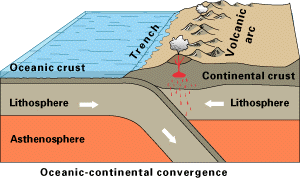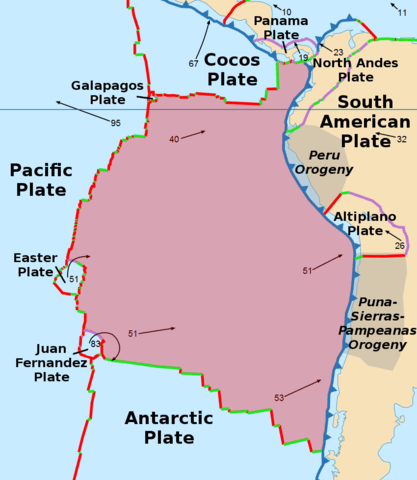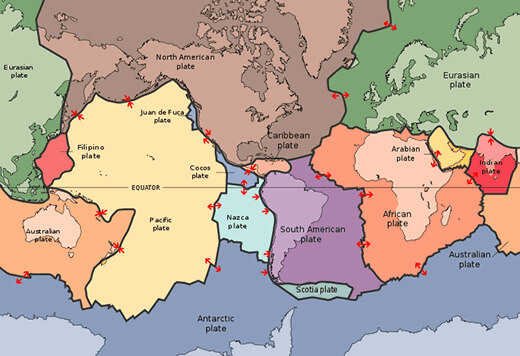The Nazca Plate: A Tectonic Odyssey in the Pacific Realm
The Nazca Plate shapes the southeastern Pacific Ocean and western South America through subduction, convergent boundaries, and dynamic interactions. The Galápagos Hotspot and Galápagos Rise add further complexities to the region's geological features.
The Nazca Plate
A Tectonic Odyssey in the Pacific Realm
The Nazca Plate, an oceanic tectonic plate named after the southern region of Peru, unfolds a captivating geological narrative in the southeastern Pacific Ocean along the west coast of South America. This sizable plate, spanning approximately 15,000,000 square kilometers (5,800,000 square miles), engages in intricate interactions with neighboring plates, sculpting the region's dynamic landscape.
Plate Boundaries and Motions
The Nazca Plate shares its borders with the Pacific Plate to the west, the Antarctic Plate through the East Pacific Rise, and the Chile Rise to the south. The plate exhibits both convergence towards the east with the South American Plate and divergence with the Antarctic, Pacific, and Cocos Plates. This complex interplay of convergent and divergent motions shapes the seismic character of the region, influencing geological phenomena like subduction and volcanic activities.
Chile Triple Junction: Meeting of the Plates
A remarkable geological feature, the Chile Triple Junction, marks the convergence of the Nazca Plate, the South American Plate, and the Antarctic Plate on the Pacific Ocean seafloor. This junction, situated off the southern coast of Chile near the Taitao and Tres Montes Peninsula, is a testament to the intricate plate interactions beneath the ocean's surface.

Simplified sketch of the tectonic forces along most of the Andes
Subduction and Andean Volcanic Belt
One of the defining features of the Nazca Plate's dynamics is its rapid subduction beneath the west coast of South America. Along the Peru-Chile Trench, the Nazca Plate is subducted at a remarkable rate of 80 - 100 mm (3 - 4 in) per year. This subduction process primarily contributes to forming the Andean Volcanic Belt, an extensive volcanic system spanning Argentina, Bolivia, Chile, Colombia, Ecuador, and Peru. The Nazca and Antarctic Plate subduction beneath the South American Plate gives rise to this volcanic belt, showcasing the powerful geological forces at play.

Map depicting the location of the Nazca Plate.
Galápagos Hotspot and Galápagos Rise
Island Formation and Divergent Boundaries
Moving beyond the tectonic drama involving the Nazca Plate, the Galápagos Hotspot and Galápagos Rise unfold a separate geological saga. The Galápagos Hotspot, a volcanic hotspot, takes center stage in creating the Galápagos Islands and influencing aseismic ridge systems. The Galápagos Rise, a divergent boundary between the South American coast and the triple junction of the Nazca Plate, the Cocos Plate, and the Pacific Plate, adds to the complexity of the region's geology.
Volcanic Legacy: Galápagos Islands
The Galápagos Islands, a testament to the volcanic activity spurred by the Galápagos Hotspot, emerge as a distinctive feature above the Galápagos Rise. These islands, home to unique ecosystems studied by Charles Darwin, showcase the geological prowess of the hotspot in shaping the Earth's surface.
Conclusion
With its remarkable subduction, convergent boundaries, and dynamic interactions, the Nazca Plate plays a pivotal role in shaping the geological canvas of the southeastern Pacific Ocean and the western edge of South America. While operating independently, the Galápagos Hotspot and Galápagos Rise add further intricacies to the region's geological tapestry, highlighting the multifaceted nature of Earth's tectonic wonders.

Map illustrating the major tectonic plates of the world.
* "Nazca" and "Nasca" are commonly used interchangeably. Still, generally, Nasca refers to the period and culture that inhabited this area, while Nazca describes the elements, such as the region, town, and river.
